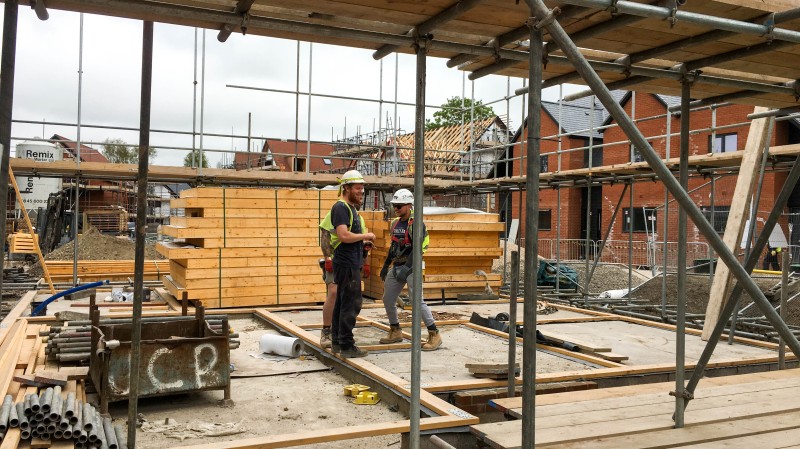You are here: How much will a basement conversion cost?
The past decade has seen considerable media coverage of ‘mega basements’ ‘created by the super wealthy in the most affluent boroughs of London, creating so-called ‘iceberg homes’. Whilst most of us do not fall into this category or fall foul of the impact of prolific basement conversions, it is worth noting that even simple basement conversions can provide an ample return for homeowners in areas where space is at a premium and there are limited or no options for extending upwards into the loft, or outwards into the garden.
As home extensions go, basement conversions are pricey. The exact cost is dependent on many factors that are highly specific to the particular property: soil type, whether your floors are concrete or suspended timber, local water table, access to the garden/road…the list goes on. Whether or not you will get a good return on this home extension will depend on the scale of the job involved (taking into account the properties of the land on which your home is built) and the value it will add to your property (bearing in mind the ceiling price of in the area).
The following article will outline approximate costs of basement conversions and highlight some of the most important points to consider.

Converting an existing basement or cellar
As a guide, Simply Basement say that converting an existing basement or cellar can cost between £1,250 and £1,450 per square metre. However, many existing basements and cellars do not have sufficient headroom for a usable living space: in this case, you would need to have the floor lowered and underpinned, increasing this cost to between £1,500 and £2,000 per square metre.
Although there are some examples of successful DIY basement conversions to be found online, it is worth bearing in mind that this type of extension is rarely straightforward and the structural ramifications of mistakes can be catastrophic. It is well worth employing professionals who specialise in basement conversions and waterproofing for this job.
Retrofitting a basement
Retrofitting a basement involves excavating and underpinning a new basement where there was none previously, and can cost between £2,200 and £3,000 per square metre according to Simply Basement. Add to this any extras (lightwells and external access, if desired), and you could be set back an additional £5,500-£9,500.
The project will also involve architectural and structural engineers’ fees: these will be in the range of £1500-£1800 for the most basic plans, and £5,000-£10,000 for more detailed design packages.
Planning Costs
If there is an existing basement space and the conversion will not involve a change to the appearance of the property, it is likely to qualify as Permitted Development. The cost associated with obtaining a Lawful Development Certificate (LDC) to ensure the development will not be queried in future is around £80-90.
If the conversion will change the appearance of the building (for example by adding external access) or you are retrofitting a basement, then planning permission will be required. In this case, you will need to factor in the cost of a planning permission application (£200-£250).
In addition, the cost of Building Regulations compliance usually falls in the region of £400-700, including the application fee and inspection.
Party Walls
If you are converting a basement in a terraced or semi-detached house, you will need to serve a Party Wall notice to neighbours in adjoining properties. This notice should be given in writing between two and 12 months in advance of construction starting. A Party Wall Surveyor will typically charge a flat fee per neighbour (many quote £100-150) for serving a notice on your behalf, but you can do this yourself using standard forms available online. The affected parties then have 14 days to respond in writing.
If neighbours agree with the proposed works, then assent is reached and the works can go ahead. A Party Wall Surveyor is not required, but it may be advisable to instruct one to draw up a Schedule of Condition, or at the very least for the homeowner and neighbour to take dated photographs of the area of their properties, to minimise the chance of disputes down the line.
If a neighbour raises an objection, or does not respond, there is said to be dissent. Here, you will have to instruct a Party Wall Surveyor to negotiate and draw up an agreement with the involved parties. In simple cases, for example where all neighbours agree to use the same independent Party Wall Surveyor, this can range in cost between £600- £1000 per neighbour, according to Home Owners Alliance. If things are more complicated, for example if each neighbour instructs their own surveyor, the cost can escalate rapidly.
With this in mind, it is strongly advised that you do everything you can to keep your neighbours on side. The best way of achieving this is by speaking to them directly and early on in the process, assuring them that you will do all you can to minimise disruption and explaining what you intend to achieve with the project. Showing them plans and drawings might be useful at this early stage, and certainly before formal notice is served.
Additional costs
If your property is on solid rock, clay, peat or marshy land, Real Homes warns the cost of excavation or lowering floors will be greater. You might also have to divert drains currently in the way of your basement plans, which will cost you yet more.
It is worth factoring in additional costs (and associated hassle) of accommodation if you need to move out during the work. According to Real Homes, if you have suspended timber flooring and there is immediate access to your garden or road for the removal of spoil, you may be able to remain at home whilst construction goes on. However, if your house has concrete floors, it would be advisable to move out during the project. The length of time you may be turfed out can vary with the scale and complexity of the project, but Simply Basement advise allowing three to five months for the major building works (excavating, underpinning, waterproofing/tanking) associated with the most noise and mess.
Waterproofing or Tanking
Protecting your extension from water is essential in basement conversions. This can take the form of either a cavity membrane system and pump, or tanking. Companies specialising in waterproofing basements provide a wide variety of quotes depending on a myriad of factors: the local water table, the area of flooring and walls to waterproof, whether the basement has arches, the quality of finish etc. Some estimates are as low as £40-£80 per metre square, others around £120 per metre square.
A cavity membrane system is when the walls are lined with a waterproof membrane which allows water to drain down into a channel. Sheets of membrane are secured with rubber-coated plugs and butyl tape. Water flows down the membrane into the channel (a ‘French Drain’, which diverts the water away from the foundations. This water is then collected in a small reservoir and pumped safely away from the walls via a ‘sump pump’. These electric pumps usually have one or two back-up batteries in case of power failure. In areas where the water table is high, constant pumping will likely be necessary.
‘Wet Basement Tanking’ involves sealing the walls of your basement with a surface coating, usually made of cementitious or bituminous material. This acts as a barrier, preventing moisture from entering the walls. Tanking requires stable brickwork, as the walls must be able to withstand the build-up of water pressure; therefore, this method might not be suitable for houses in areas where the water table and perched water table are high.
Summary
In summary, the cost of a basement conversion is dependent on many factors that are highly specific to your particular property. Whether or not you will get a good return on a basement conversion will depend on: whether you have an existing basement or cellar, the characteristics of your property (in particular the water table and soil type), the ceiling value of properties in your area and whether you have neighbouring properties to consider.
If you are looking to make some home improvements, you may find some of these services useful
Building Regulations
Find details of local experts who can help with Building Regulations
Builders
Find local help with a building project
Architectural Design Services
Find local Architectural Design experts
Structural Inspections
Find an expert to carry out a structural inspection
Building Surveys
I want a local surveyor to do a Building Survey for me
Choose which Architectural service you require
If you are not sure which service you require, check out the options available...


